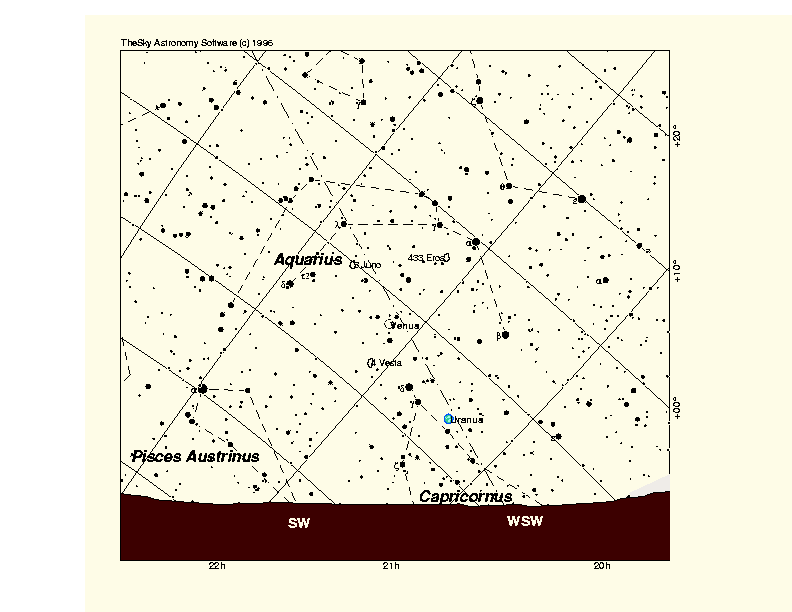Yesterday I got an email from NASA (we've been good buddies for a long time) with a link to this Voyager video. They are celebrating Voyager's 30th anniversary and right now all the Voyager planets are visible. Jupiter is easy. Go out in the evening and look south. The bright "star" you see is Jupiter. It is above and slightly to the left of Antares, the brightest star in Scorpius. Saturn is not too hard to see either, except right now it is only right before dawn next to Regulus, the brightest star in Leo. They are in the east at sunrise, below Venus.
Uranus and Neptune are harder. Uranus can in theory be seen with the naked eye and Neptune with good binoculars. For me, more like binoculars for Uranus and my telescope for Neptune. I tried for Uranus last night. I had many problems.
I did my looking near home. Lancaster is better than the big city and is at 2400ft, but there is still light. I could walk to the vacant field next to the freeway for a little less light. When I got there I noticed light clouds blowing through.
Uranus is in Aquarius. I at least now know where Aquarius is. However, Aquarius is a very dim galaxy, only well know because it is in the zodiac. (The astrological signs, but also the constellations through which the sun and planets move. There are actually 13 constellations the sun moves through. Twelve you hear about in astrology: Aries, Taurus, Gemini, Cancer, Leo, Virgo, Libra, Scorpius, Sagittarius, Capricornus, Aquarius and Pisces. The thirteenth is Ophiuchus which is above Scorpius.) I have never seen Aquarius and I could not see it with the clouds and city lights. I did find Formalhaut, the bright star in Pisces Australis. That was a new find for me. I also found Corona Australis right behind Scorpius, another new find. I called it a night and went back home. There I checked on my new finds using star charts on the computer.
Even though I had called it a night, I decided to try to understand more about where Uranus is. The NASA video shows where Uranus is, but it is not very precise. It does show Uranus at the front of Aquarius. Here is what Aquarius' pictures look like.

I use the interactive star chart from Sky and Telescope. It's Aquarius line drawing is different than this picture and the NASA video, which caused me some confusion. I found Uranus' precise location online in Sky and Telescope. Here is their picture.

This is very precise but gives no context. The Sky and Telescope interactive star chart is very wide field and has no star markings. I looked at the The Wikipedia chart of Aquarius which has context and at least labels some of the stars.

The ecliptic (the path of the sun and planets) is the red dotted line. All of Aquarius and some surrounding stuff is shown with star labels. Using this I went out and found the Aquarius delta (δ) and lambda (λ) stars. (Stars are labeled with Greek letters. The first Greek letter, alpha (α), is the brightest, then beta (β), gamma (γ), delta (δ), epsilon (ε) and so on. Even α Aqr is not very bright. Phi (φ) , chi (χ) and psi (ψ) -- numbers 21, 22 and 23 in the Greek alphabet -- are even dimmer. They are not in most charts because there are 20 brighter stars in the constellation.)
Armed with new information I decided to go back out. To find δ and λ I first found Formalhaut and scanned up and left with my binoculars. I was very happy. I thought that Uranus was near λ because I forgot the designations on the Sky and Telescope picture.
I came home and found I was wrong about Uranus (but still happy to have found stars in Aquarius). I found a more precise chart.

I went back out and confirmed my star finding, but still could not find Uranus. Even this chart did not have φ, χ and ψ Aqr. (This chart is from 2001. Uranus has moved since then so I could not use this chart's Uranus location last night.) I needed a better star chart. I figured I could use Google Sky because it zooms and shows context. It also labels stars if you have the Yale Bright Star catalog turned on. However, Carolina was doing her homework on the computer with Google Sky. Now I really called it a night and began to move toward bed.
Before I got to bed Carolina finished using the computer. Even though it was late -- about eleven when Carolina was done -- I checked Google Sky. Viola! Google Sky showed me φ, χ and ψ Aqr in context. I went back out and found Uranus, right above φ Aqr just like Sky and Telescope said. λ was actually pretty close. The ψ Aqr stars are a bit left of λ Aqr. I had already seen the ψ stars but didn't know it. I just needed to look up a bit to find χ, φ and Uranus. It's not much to look at in suburb light, but I was very happy. I can actually find stuff and navigate with my binoculars!
Today I'm at bit tired but happy.


No comments:
Post a Comment